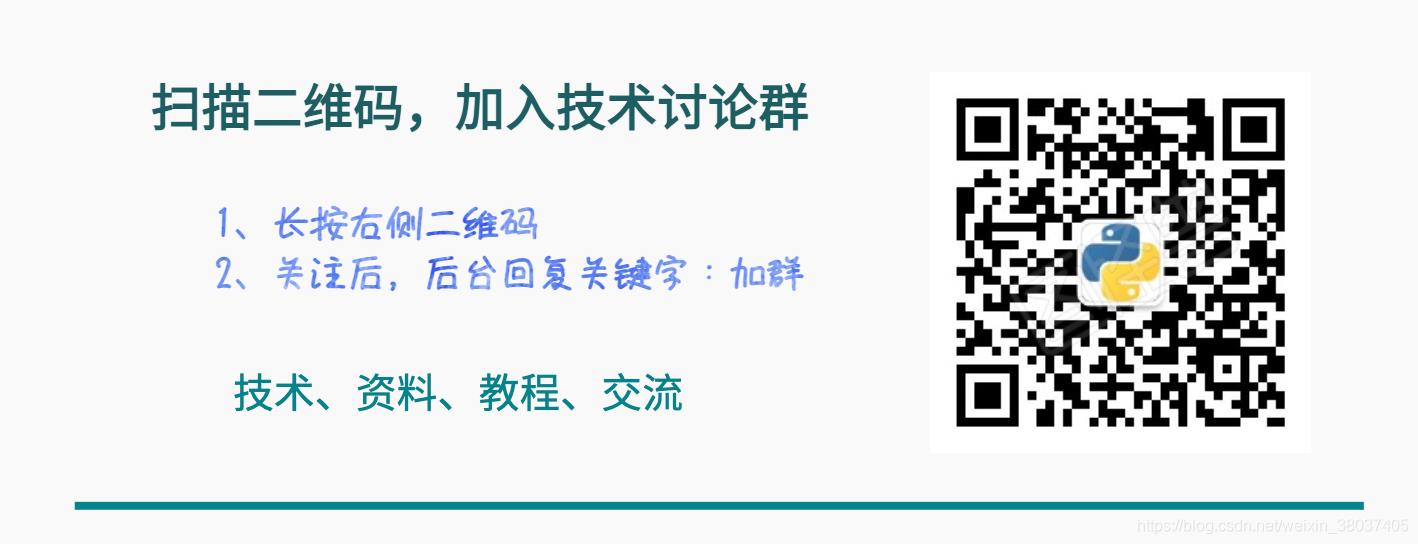赶快收藏,好用到起飞的 30 个 Python 小技巧
Posted Python学习与数据挖掘
tags:
篇首语:本文由小常识网(cha138.com)小编为大家整理,主要介绍了赶快收藏,好用到起飞的 30 个 Python 小技巧相关的知识,希望对你有一定的参考价值。
Python 是最流行的语言之一,许多人将其用于数据科学和机器学习、Web 开发、脚本编写、自动化等领域。
这种流行的部分原因是它的简单性和易于学习。
在本文中,我将向大家介绍 30 个简短、实用的 Python 技巧。内容较多,建议收藏学习,喜欢点赞支持,文末提供技术交流群。
1. All unique
下面的方法检查给定的列表是否有重复的元素,它使用 set() 的属性从列表中删除重复的元素。
def all_unique(lst):
return len(lst) == len(set(lst))
x = [1,1,2,2,3,2,3,4,5,6]
y = [1,2,3,4,5]
all_unique(x) # False
all_unique(y) # True
2.字谜
此方法可用于检查两个字符串是否为字谜。 字谜是通过重新排列不同单词或短语的字母而形成的单词或短语,通常只使用一次所有原始字母。
from collections import Counter
def anagram(first, second):
return Counter(first) == Counter(second)
anagram("abcd3", "3acdb") # True
3. 内存
此代码段可用于检查对象的内存使用情况。
import sys
variable = 30
print(sys.getsizeof(variable)) # 24
4. Byte 大小
此方法以 Byte 为单位返回字符串的长度。
def byte_size(string):
return(len(string.encode('utf-8')))
byte_size('😀') # 4
byte_size('Hello World') # 11
5. 打印一个字符串 N 次
此代码段可用于打印字符串 n 次,而无需使用循环来执行此操作。
n = 2
s ="Programming"
print(s * n) # ProgrammingProgramming
6. 首字母大写
此代码段仅使用 title() 方法将字符串中每个单词的首字母大写。
s = "programming is awesome"
print(s.title()) # Programming Is Awesome
7.列表切割
此方法将列表分为指定大小的较小列表。
def chunk(list, size):
return [list[i:i+size] for i in range(0,len(list), size)]
8. 删除虚假值
此方法使用 filter() 从列表中删除虚假值(False、None、0 和“”)
def compact(lst):
return list(filter(None, lst))
compact([0, 1, False, 2, '', 3, 'a', 's', 34]) # [ 1, 2, 3, 'a', 's', 34 ]
9. 转置二维数组
此代码段可用于转置二维数组
array = [['a', 'b'], ['c', 'd'], ['e', 'f']]
transposed = zip(*array)
print(transposed) # [('a', 'c', 'e'), ('b', 'd', 'f')]
10. 链式比较
您可以在一行中对各种运算符进行多次比较。
a = 3
print( 2 < a < 8) # True
print(1 == a < 2) # False
11.逗号分隔
此代码段可用于将字符串列表转换为单个字符串,列表中的每个元素用逗号分隔。
hobbies = ["basketball", "football", "swimming"]
print("My hobbies are:") # My hobbies are:
print(", ".join(hobbies)) # basketball, football, swimming
12.获取元音
此方法获取字符串中的元音(‘a’、‘e’、‘i’、‘o’、‘u’)
def get_vowels(string):
return [each for each in string if each in 'aeiou']
get_vowels('foobar') # ['o', 'o', 'a']
get_vowels('gym') # []
13. 转化
此方法可用于将给定字符串的第一个字母转换为小写。
def decapitalize(str):
return str[:1].lower() + str[1:]
decapitalize('FooBar') # 'fooBar'
decapitalize('FooBar') # 'fooBar'
14. 压平
以下方法使用递归来展平潜在的深层列表。
def spread(arg):
ret = []
for i in arg:
if isinstance(i, list):
ret.extend(i)
else:
ret.append(i)
return ret
def deep_flatten(xs):
flat_list = []
[flat_list.extend(deep_flatten(x)) for x in xs] if isinstance(xs, list) else flat_list.append(xs)
return flat_list
deep_flatten([1, [2], [[3], 4], 5]) # [1,2,3,4,5]
15. 差异
此方法通过仅保留第一个中的值来查找两个迭代之间的差异。
def difference(a, b):
set_a = set(a)
set_b = set(b)
comparison = set_a.difference(set_b)
return list(comparison)
difference([1,2,3], [1,2,4]) # [3]
16. 差异化
在将给定函数应用于两个列表的每个元素后,以下方法返回两个列表之间的差异。
def difference_by(a, b, fn):
b = set(map(fn, b))
return [item for item in a if fn(item) not in b]
from math import floor
difference_by([2.1, 1.2], [2.3, 3.4], floor) # [1.2]
difference_by([ 'x': 2 , 'x': 1 ], [ 'x': 1 ], lambda v : v['x']) # [ x: 2 ]
17. 链式函数调用
您可以在一行中调用多个函数
def add(a, b):
return a + b
def subtract(a, b):
return a - b
a, b = 4, 5
print((subtract if a > b else add)(a, b)) # 9
18.重复值
以下方法通过使用 set() 仅包含唯一元素这一事实,来检查列表是否具有重复值。
def has_duplicates(lst):
return len(lst) != len(set(lst))
x = [1,2,3,4,5,5]
y = [1,2,3,4,5]
has_duplicates(x) # True
has_duplicates(y) # False
19. 合并两个字典
以下方法可用于合并两个字典
def merge_two_dicts(a, b):
c = a.copy() # make a copy of a
c.update(b) # modify keys and values of a with the ones from b
return c
a = 'x': 1, 'y': 2
b = 'y': 3, 'z': 4
print(merge_two_dicts(a, b)) # 'y': 3, 'x': 1, 'z': 4
在 Python 3.5 及更高版本中,您还可以像下面这样:
def merge_dictionaries(a, b):
return **a, **b
a = 'x': 1, 'y': 2
b = 'y': 3, 'z': 4
print(merge_dictionaries(a, b)) # 'y': 3, 'x': 1, 'z': 4
20. 将两个列表转换成字典
以下方法可用于将两个列表转换为字典
def to_dictionary(keys, values):
return dict(zip(keys, values))
keys = ["a", "b", "c"]
values = [2, 3, 4]
print(to_dictionary(keys, values)) # 'a': 2, 'c': 4, 'b': 3
21.使用枚举
此代码段显示您可以使用 enumerate 来获取列表的值和索引。
list = ["a", "b", "c", "d"]
for index, element in enumerate(list):
print("Value", element, "Index ", index, )
# ('Value', 'a', 'Index ', 0)
# ('Value', 'b', 'Index ', 1)
#('Value', 'c', 'Index ', 2)
# ('Value', 'd', 'Index ', 3)
22. 计算花费的时间
此代码段可用于计算执行特定代码所需的时间。
import time
start_time = time.time()
a = 1
b = 2
c = a + b
print(c) #3
end_time = time.time()
total_time = end_time - start_time
print("Time: ", total_time)
# ('Time: ', 1.1205673217773438e-05)
23. try/else
您可以将 else 子句作为 try/except 块的一部分,如果没有抛出异常,就会执行该块。
try:
2*3
except TypeError:
print("An exception was raised")
else:
print("Thank God, no exceptions were raised.")
#Thank God, no exceptions were raised.
24. 统计最频繁
此方法返回列表中出现频率最高的元素。
def most_frequent(list):
return max(set(list), key = list.count)
numbers = [1,2,1,2,3,2,1,4,2]
most_frequent(numbers)
25. 回文
此方法检查给定字符串是否为回文。
def palindrome(a):
return a == a[::-1]
palindrome('mom') # True
26. 没有 if-else 的计算器
下面的代码片段展示了如何在不需要使用 if-else 条件的情况下编写一个简单的计算器。
import operator
action =
"+": operator.add,
"-": operator.sub,
"/": operator.truediv,
"*": operator.mul,
"**": pow
print(action['-'](50, 25)) # 25
27.shuffle
此代码段可用于随机化列表中元素的顺序。 请注意,shuffle 就地工作,并返回 None。
from random import shuffle
foo = [1, 2, 3, 4]
shuffle(foo)
print(foo) # [1, 4, 3, 2] , foo = [1, 2, 3, 4]
28. 列表展平
此方法类似于 javascript 中的 [].concat(…arr) 将列表展平。
def spread(arg):
ret = []
for i in arg:
if isinstance(i, list):
ret.extend(i)
else:
ret.append(i)
return ret
spread([1,2,3,[4,5,6],[7],8,9]) # [1,2,3,4,5,6,7,8,9]
29. 交换值
这是交换两个变量而无需使用额外变量的一种非常快速的方法。
a, b = -1, 14
a, b = b, a
print(a) # 14
print(b) # -1
30. 获取缺失键的默认值
此代码段显示了在字典中未包含您要查找的键的情况下如何获取默认值。
d = 'a': 1, 'b': 2
print(d.get('c', 3)) # 3
技术交流
欢迎转载、收藏、有所收获点赞支持一下!

目前开通了技术交流群,群友已超过2000人,添加时最好的备注方式为:来源+兴趣方向,方便找到志同道合的朋友
- 方式①、发送如下图片至微信,长按识别,后台回复:加群;
- 方式②、添加微信号:dkl88191,备注:来自CSDN
- 方式③、微信搜索公众号:Python学习与数据挖掘,后台回复:加群

以上是关于赶快收藏,好用到起飞的 30 个 Python 小技巧的主要内容,如果未能解决你的问题,请参考以下文章